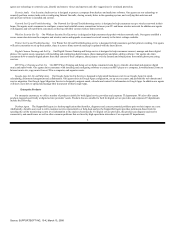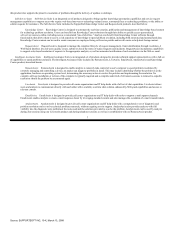Support.com 2007 Annual Report Download - page 20
Download and view the complete annual report
Please find page 20 of the 2007 Support.com annual report below. You can navigate through the pages in the report by either clicking on the pages listed below, or by using the keyword search tool below to find specific information within the annual report.
we failed to close expected perpetual licenses with up-front revenue resulting in a revenue shortfall. If in future quarters we fail to close orders expected to be
completed by the end of a quarter, particularly if these orders are for perpetual licenses with up-front revenue, our quarterly results would suffer and the market
price of our common stock would likely decline. While revenues in our consumer business are generally recognized over the course of a quarter based on the
number of services delivered, this revenue is not significant enough at this time to offset a shortfall in perpetual license revenue.
Our inability to meet future financial performance targets that we announce or that are published by research analysts could cause the market price of
our common stock to decline.
From time to time, we provide guidance related to our future financial performance. In addition, financial analysts publish their own expectations of our
future financial performance. Because our quarterly revenue and our operating results fluctuate, future financial performance is difficult to predict. In the past,
including the third quarter of 2007, we have failed to meet our guidance. As it did following the announcement of our third quarter results, future downward
adjustments of our guidance or the failure to meet our guidance or the expectations of research analysts would likely cause the market price of our common stock
to decline.
Management's ability to accurately predict performance is affected in large part by a significant portion of our total revenue being dependent upon the
closing of new large customer orders. In addition, our guidance is based in part upon the expectation of new product sales and services offerings, including our
consumer business, with which we have a limited history. A significant portion of our consumer business is dependent upon relationships with consumer support
partners, including retailers. We sell to numerous consumers through each of these partners, and therefore a delay in the acquisition or rollout of our relationship
with even one of these partners could cause us to miss revenue targets. In the event we fail to achieve projected revenue levels in any quarter, we will be unable
to reduce our expenses for that quarter in a corresponding fashion, and our results will not meet our guidance or the expectations of securities analysts or
investors, which would likely cause the market price of our common stock to decline.
The trading market for our common stock relies in part on the research and reports that industry or financial analysts publish about us or our business. We
do not control these analysts. If one or more of the analysts who currently cover us downgrade our stock, our stock price would likely decline rapidly.
Furthermore, if one or more of these analysts cease coverage of us, we could lose visibility in the market, which in turn could cause the market price of our stock
to decline.
Finally, the market prices of software companies have been extremely volatile. Stock prices of many software companies have often fluctuated in a manner
unrelated or disproportionate to the operating performance of such companies. In the past, following periods of market volatility, stockholders have often
instituted securities class action litigation relating to the stock trading and price volatility of the software company in question, including SupportSoft. Any
securities litigation we are involved in could result in substantial cost to us to defend and divert resources and the attention of management from our business.
Our consumer business will increase operating expenses without any assurance of yielding increased revenue.
We are executing a plan to extend our business by providing premium technology support services. In addition to continuing to offer our software to
corporate customers, we are offering technology support to consumers through our alliance partners and directly. We may not be able to offer these new services
successfully. We have limited experience in reaching or serving consumers or in managing customer support agents. We expect that many of our agents will be
home-based, which will require a high degree of coordination and quality control of employees working from diverse and remote
16
Source: SUPPORTSOFT INC, 10-K, March 13, 2008
























